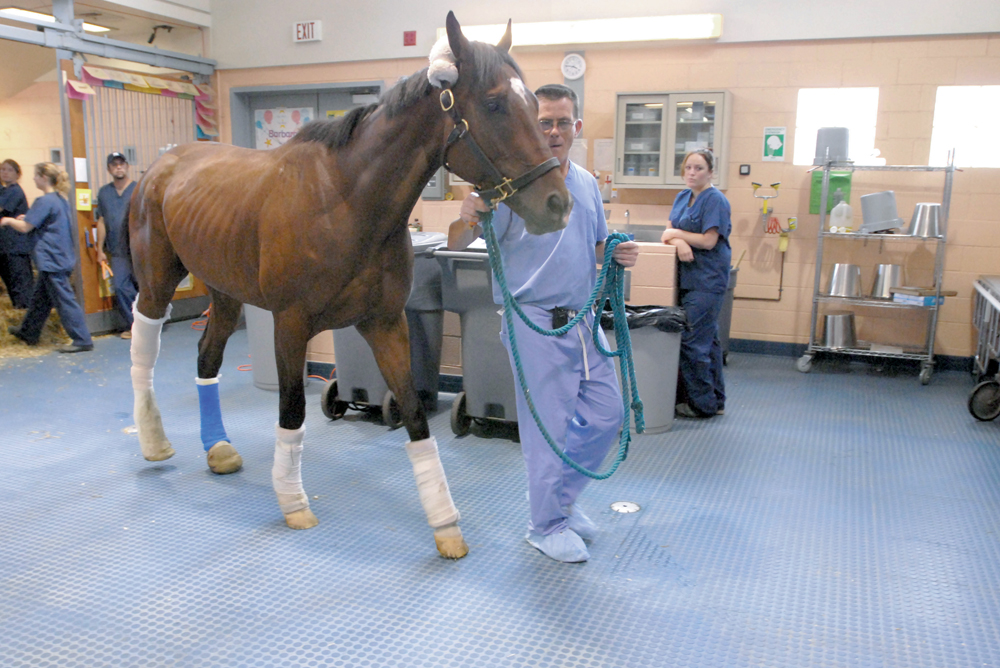Barbaro Loses Battle with Laminitis
Jan. 30, 2007
Dr. Dean Richardson leads Kentucky Derby winner Barbaro around the ICU at New Bolton Center in Kennett Square, Pa., on July 14, 2006. (Photo: University of Pennsylvania)
As Barbaro romped across the finish line of the Kentucky Derby on May 6, 2006, it looked like nothing could stop the undefeated 3-year-old bay colt.
Eight months later, his owners and veterinarian announced to the world through tears that they felt they had no choice but to put him down.
The laminitis in his left hind had worsened, causing complications to his repaired right hind; and a fairly severe case of laminitis also had developed in both front legs from the horse overloading the front end to alleviate the pain in the back.
“That left him with not a good leg to stand on,” Dr. Dean Richardson said to a packed room of reporters gathered at New Bolton Center in Kennett Square, Pa.
Barbaro was euthanized Jan. 29, 2007, a Monday morning, after a weekend of setbacks.
Richardson and owners Roy and Gretchen Jackson described how the disease had affected Barbaro’s personality by Sunday. The champion’s eyes no longer glistened, showing sadness and distress. The usually laid-back horse couldn’t get comfortable and had a bad night Sunday night.
“You could see he was upset,” Richardson said. “That was the difference. It was more than we wanted to put him through.”
It was a sad ending to Barbaro’s very public struggle to survive that perhaps showed even more heart than his memorable 6 1/2-length Derby victory.
The horse had survived nearly two dozen surgeries and other procedures. Weeks of positive reports had turned into months.
But, his medical outlook changed quickly in January, and, in the end, laminitis claimed another victim, showing no mercy to the global superstar.
The beloved thoroughbred’s legacy to the veterinary world may be in putting a celebrity face on a disease that was virtually unknown to the general public. Some industry experts speculated that his struggle would create more support for research.
Richardson acknowledged that he learned a lot through the process and believes he would have better results if he went through the same ordeal with another horse.
“I honestly believe I would have a better chance to save his life, because I would probably not make the same mistakes,” Richardson said. “I’m sure I made mistakes. Everybody makes mistakes, or knows of things you could have done better.”
As late as December 2006, Barbaro looked like he was on the mend. With his right hind nearly healed and his laminitis seemingly in check, he was enjoying his daily walks outside, and there was talk of moving him home. But Richardson cautioned once again that the left hind foot was a “formidable long-term challenge.”
On Jan. 10, Richardson had to remove more damaged tissue from Barbaro’s left hind hoof, and the colt was placed back in a protective sling.
On Jan. 13, another section of his left rear hoof was removed.
Forced to continue bearing more weight on his healing right hind leg, within two weeks, Barbaro developed a deep subsolar abscess in his right hind foot.
His veterinary team attempted to manage the foot in a cast and then in a custom fabricated brace, but it didn’t allow access to the foot or acceptable stability and comfort. Surgeons next tried putting his right hind in an external skeletal fixation device, placing two steel pins transversely through his right hind cannon bone. These pins are connected to external sidebars connected to a lightweight alloy foot plate, eliminating all weight bearing from the foot; the horse’s weight is carried through the pins across his cannon bone.
The procedure carried risks, including the possibility that the cannon bone couldn’t hold up to that kind of stress. The team also expressed concern about the front feet, forced once again to shoulder more than average weight.
It was the development of laminitis in the front feet that was the breaking point, Richardson said.
As word spread of Barbaro’s death, fans young and old showed up at the New Bolton Center with cards, flowers and gifts, and thousands of e-mails poured into the hospital’s website.
At his press conference, Richardson, chief of surgery at New Bolton, said: “I really didn’t think it was appropriate to continue treatment because the probability of getting better was so poor.”
Asked whether he got any gratification from the ordeal, Richardson said the one thing he could say for sure was: “Barbaro had many, many good days.”